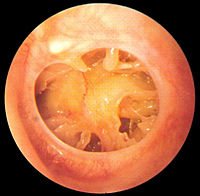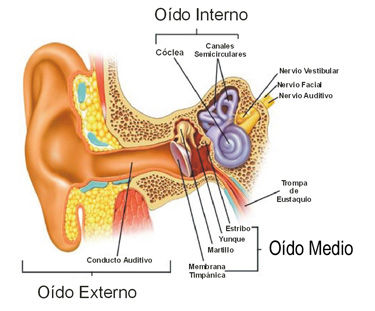Perforación grande del tímpano

Hearing impairment in adults
What is hearing impairment?
Broadly speaking, hearing impairment in adults can be divided into two main groups:
- Hearing impairment caused by alteration to the outer ear (ear canal) or to the middle ear (the eardrum or the chain of tiny bones connected to it). This is called conductive hearing impairment.
- Hearing impairment caused by alteration to the inner ear. This is called sensorineural hearing impairment.

Conductive hearing impairment
It can be caused by:
- otosclerosis: otosclerosis is a disease affecting a tiny bone in the ear called the stapes, which causes progressive hearing loss or deafness in one or both ears;
- cholesteatoma: cholesteatoma is a benign tumour in the ear which initially affects the eardrum and the tiny bones (ossicles) in the ear (malleus, incus and stapes);
- perforated eardrum: a perforated eardrum is a hole or tear in the eardrum;
- chronic otitis media: in these cases, in general, the deafness or hearing loss can be treated or improved with a tympanoplasty.
What is a tympanoplasty?
A tympanoplasty is surgery to correct alterations to the eardrum and/or the tiny bones in the middle ear. If the eardrum is affected, it will be replaced by a graft obtained from the patient’s skin without leaving a scar, thus closing the partial or total perforation.
If the tiny bones of the middle ear (malleus, incus or stapes) are affected, we will replace them a prosthesis.
If the deafness or hearing loss is considerable, we will also resort to osseointegrated implants.
What are osseointegrated implants?
They are mainly used in:
- patients with chronic ear discharge which will prevent the use of a hearing aid.
- patients with a constricted ear entrance and ear canal, usually caused by atresia or exostosis, meaning that there is not enough space to fit the hearing aid.

Sensorineural hearing impairment
What can be done if hearing aids do not work?
In these cases, the problem lies in the inner ear. Patients will usually report that they “can hear but not understand”.
The first stage of treatment will be fitting a hearing aid, and if this does not bring about any improvement, we will resort to middle ear implants or to cochlear implants.
What is a middle ear implant?
A middle ear implant is a small electronic prosthesis that is fitted by means of a surgical procedure in patients suffering from hearing impairment or deafness. In cases of presbycusis (age-related hearing loss, equivalent to presbyopia or eye-strain), the prosthesis is inserted into the ossicular chain (the network of small bones), increasing mobility and improving the transmission of sound, from the outside to the auditory nerve.
What is a cochlear implant?
A cochlear implant is a device that enables individuals with severe deafness or hearing impairment to recover their hearing and is only the effective treatment that exists today for this type of deafness. Hearing impairment is considered to be severe when the patient cannot understand words, even when wearing a hearing aid.
A surgical procedure is performed to fit an electronic device in the inside of the ear, which transforms sound into an electric signal, which in turn stimulates the auditory nerve.
The procedure takes around 90 minutes, is carried out under general anaesthetic and only requires an overnight stay in hospital.
After surgery, most patients will need monitoring and/or a speech therapy to correctly interpret the auditory information transmitted by the cochlear implant and therefore understand and use language correctly.
Hearing impairment or deafness can develop at any age, which is why cochlear implants can be used by patients between 6 months and 80 years of age. For use in elderly patients, the only requirement is to be in good health. In children the implants are highly effective, enabling their normal linguistic development if they are fitted early on (ideally before 3 years of age). In adults who have lost their hearing after having already developed the ability to hear (after having acquired language), results will depend on how much time has passed since the hearing loss.
 by Develona
by Develona